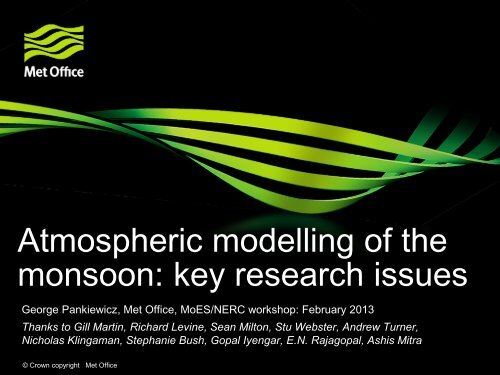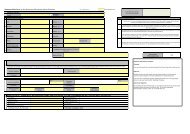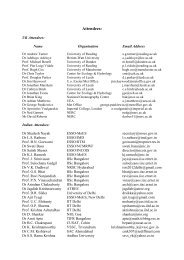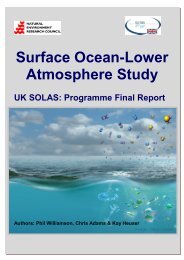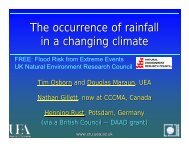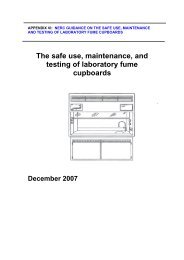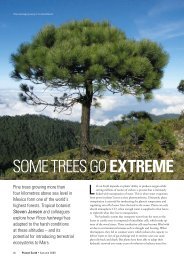Dr Pankiewicz's presentation - NERC
Dr Pankiewicz's presentation - NERC
Dr Pankiewicz's presentation - NERC
Create successful ePaper yourself
Turn your PDF publications into a flip-book with our unique Google optimized e-Paper software.
Atmospheric modelling of the<br />
monsoon: key research issues<br />
George Pankiewicz, Met Office, MoES/<strong>NERC</strong> workshop: February 2013<br />
Thanks to Gill Martin, Richard Levine, Sean Milton, Stu Webster, Andrew Turner,<br />
Nicholas Klingaman, Stephanie Bush, Gopal Iyengar, E.N. Rajagopal, Ashis Mitra<br />
© Crown copyright Met Office
Understanding and evaluating<br />
monsoon processes<br />
• The monsoons: still a challenge for modelling on a<br />
range of timescales<br />
• Known sensitivities:<br />
• convection and boundary layer parametrisation<br />
• cloud microphysics<br />
• land surface properties<br />
• orography<br />
• model resolution (atmosphere, ocean, horizontal, vertical)<br />
• coupled model SST biases<br />
© Crown copyright Met Office
Rapid development of biases:<br />
1 - 5 days<br />
1-day NWP forecast<br />
5-day forecast error<br />
• Rapid growth of west equatorial Indian Ocean precipitation bias in<br />
the first 5 days<br />
• Also lack of a wave-like pattern in the low-level circulation.<br />
• Rapid growth of error suggests that it is a direct impact of<br />
parameterisations and not due to a non-linear feedback process<br />
operating on longer time-scales.<br />
© Crown copyright Met Office
Common systematic biases: CMIP5<br />
CanESM2 CNRM-CM5 CSIRO-Mk3-8-0 inmcm4<br />
IPSL-CM5-LR MIROC-ESM-CHEM MIROC-ESM MIROC4h<br />
Few models can simulate the major precipitation<br />
centres and their interannual variation.<br />
Equatorial Indian Ocean precipitation / SST<br />
biases are common in many models.<br />
MIROC5 HadCM3 HadGEM2-CC HadGEM2-ES<br />
Many models underestimate rainfall over India.<br />
Himalayan rainfall bias common in many models.<br />
MPI-ESM-LR MRI-CGCM3 NCAR/CCSM4 NorESM1-M<br />
© Crown copyright Met Office
The role of Arabian Sea SST bias<br />
Strong monsoons depend on Arabian<br />
Sea moisture in observations<br />
• Large systematic cold SST<br />
errors in Arabian Sea reduce<br />
monsoon rainfall (up to 30%)<br />
and delay onset by weakening<br />
local evaporation.<br />
• Cold Arabian Sea SST errors<br />
develop in winter due (in part)<br />
to excessive winter monsoon<br />
northerlies.<br />
• This tends to reduce Indian<br />
rainfall, particularly in June.<br />
• Inter-model spread of early<br />
monsoon rainfall for future<br />
scenarios is more constrained<br />
in CMIP5 models with large<br />
cold Arabian Sea SST biases.<br />
© Crown copyright Met Office<br />
Idealised re<strong>presentation</strong> of SST bias<br />
Coupled model SST biases and the effect of (1) & (2) on<br />
HadGEM3-A (rainfall and vertically-integrated moisture flux)<br />
Richard Levine
Convection time-series analysis<br />
Suppression of intense deep convection results in less intermittent behaviour<br />
at time-step level allowing more continuous rainfall<br />
Over India there are improvements consistent with feedback from suppressing<br />
equatorial convection and direct improvement of diurnal cycle (rainfall at night)<br />
Equatorial Indian Ocean (67.5E,0N):<br />
deep convective precip<br />
Control<br />
Test<br />
Indian land (81E,21N): deep (solid) /<br />
mid-level (dotted) convective precip<br />
© Crown copyright Met Office<br />
Time-step<br />
Time-step
INTEGRATE Progress<br />
End of Year 1<br />
Goal: Build coupled atmosphere-ocean-ice-aerosol model<br />
Reduce Model Systematic Errors<br />
• Model development ► evaluation ► processes ► development<br />
• GA4.0 Released<br />
• UM User workshop Review & Report<br />
• ENDGame<br />
• Improved Variability - Tropics & Extratropics.<br />
• Improved Stability.<br />
• Warm Bias at TTL - issue for Stratospheric Chemistry<br />
• GA5.0 Physics?<br />
• Convection - Entrainment increase - Improved MJO<br />
• 5A GWD<br />
• GO & GSI 5.0 under development
Frequency-wavenumber spectra of<br />
precipitation<br />
Preliminary GA5.0 Package (GA4.0#73.4.1)<br />
Observed<br />
N96 ENDGame N96 GA4.0 package AMIP GA4.0#73.4.1<br />
© Crown copyright Met Office
Limited Area Model<br />
Configurations<br />
Model<br />
Climate<br />
NWP like<br />
Like<br />
4 km 2.2 km 1.5 km<br />
Horiz Grid 50 x 50 200 x200 1150 x 1150 2000 x2000 3000 x 3000<br />
Vertical Levels L70, 80 km lid L118, 78 km lid<br />
Timestep (s) 1200 600 10<br />
Convection Parametrized Explicit<br />
Sub-grid mixing 1D BL 3D Smagorinsky<br />
Critical RH<br />
92% (z=0) ⇒ 80%<br />
(z≥3km)<br />
99%<br />
4500km<br />
4500km<br />
• All LAMs span the same domain, nested directly inside the global model<br />
• All LAMs initialised with the same data (the 18th 00z global model flow<br />
fields) and thereafter free running<br />
• All LAMs forced with the same lateral boundary conditions, and with<br />
SSTs updated daily using Met Office OSTIA analyses<br />
• Configuration therefore allows as clean an assessment of the impact of<br />
horizontal resolution as possible<br />
© Crown copyright Met Office
1.5 km model<br />
NWP model<br />
Climate Model<br />
NWP & climate models show typical conv. parameterisation behaviour:<br />
• Rainfall grid-scale in nature in both time and space.<br />
• Strong diurnal cycle over land peaking at 07Z (local noon) rather than<br />
early evening<br />
• Plot to right indicates far too little rainfall over land relative to TRMM<br />
• Too much rainfall over the sea (not shown)<br />
All these features much improved in 1.5 km explicit convection simulation
© Crown copyright Met Office<br />
Future challenges<br />
• Re<strong>presentation</strong> of flow and rainfall over steep orography:<br />
• What does it really look like? Are the observations good enough?<br />
• High-resolution (convection-permitting) regional simulations may help<br />
• Coupled model SST biases – errors in mean state feed back on<br />
monsoon climatology, variability and teleconnections<br />
• Should these be the priority? (e.g. equatorial Indian Ocean)<br />
• Climatology versus variability<br />
• Hard to get both right<br />
• More wide-spread, high frequency rainfall observations (land & ocean)<br />
• Poor ENSO - monsoon teleconnections<br />
• Influenced by SST biases and overall tropical circulation biases<br />
• Incorrect convection-dynamics coupling and/or incorrect diabatic heating?<br />
• Future projections<br />
• More complex processes needed to simulate complex feedbacks?<br />
• But need to reduce basic model systematic biases
Thank You<br />
© Crown copyright Met Office
GA4.0<br />
GA5.0 - GA4.0<br />
ENDGame/GA5.0 Impacts:<br />
Tropical Water Cycle<br />
JJA AMIP<br />
GA4.0 - MERRA GA5.0 - MERRA<br />
Hadley Circulation -<br />
Less ascent on equator<br />
Reduced Errors<br />
GA4.0<br />
GA5.0 - GA4.0<br />
GA4.0 - GPCP<br />
GA5.0 - GPCP<br />
Tropical Precipitation -<br />
Reduced ITCZ precipitation<br />
Reduced Indian Ocean Precip<br />
&<br />
Increase over India<br />
Preliminary GA5.0 Package<br />
(GA4.0#73.4.1)
Process Evaluation Groups<br />
1. African processes<br />
2. MJO & its teleconnections<br />
3. South Asian Monsoon<br />
4. Blocking and Stormtracks<br />
5. Tropical Cyclones<br />
6. ENSO & its teleconnections<br />
7. Ocean Biases (North Atlantic & Southern Ocean Focus)<br />
8. Clouds, Radiation and Light Rain<br />
9. Continental Surface Temperature Biases<br />
10. Conservation<br />
© Crown copyright Met Office
Summary<br />
• Representing monsoon systems, including variability and response to<br />
climate change, is an on-going challenge for modelling groups<br />
• Many common errors are forced locally (in time and space) although<br />
some are related to biases which develop during the preceding winter<br />
(e.g. Arabian Sea SST cold bias)<br />
• Systematic errors develop rapidly (within 2 weeks for atmosphere and<br />
first month for SSTs)<br />
• Sensitivity to model resolution is weaker than sensitivity to model<br />
physics<br />
• The additional functionality afforded by including extra model processes<br />
can be offset by interactions with other model errors<br />
• Observations of cloud characteristics and rainfall intensity, on sub-daily<br />
timescales, over Indian land and ocean, would help greatly<br />
© Crown copyright Met Office


